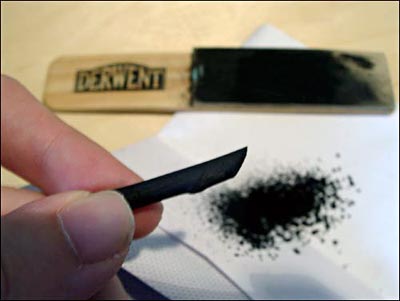Charcoal for DrawingVine Willow Charcoal | |
| VINE CHARCOAL is typically created by the slow burning of willow branches (see article : how to make charcoal) to create a smooth charcoal that is easy to draw and sketch with, and can be purchased in a variety of hardness’s. Occasionally, a manufacturer will shape the sticks to give a more unified appearance, but just as a banana, chosen for its shape by the supermarkets, tastes no different from any other, it really doesn’t matter much what shape your charcoal sticks come in. When gum binder is added, the charcoal (known as compressed charcoal) can achieve richer blacks, but is less malleable as a result. Compressed charcoal can be bought in stick form and is typically what you will find in charcoal pencils. Willow charcoal has an even consistency, and can easily be removed by rubbing with your hand or a piece of material. This also makes it ideal for use as an under drawing for oil painting, though it is important to fix the drawing in some manner. The softness of the vine does mean the sticks quickly lose their fine edges, but this is something that can be overcome either by technique in drawing and/or by using sandpaper to keep a sharp point (see below). Historically willow charcoal was also used in tablet form for gastric and intestinal disorders such as indigestion, heartburn, acid stomach as well as hiding the smell of bad breath from smoking! How to Sharpen Vine Charcoal The best means in which to sharpen your thin charcoal sticks is with a piece of sandpaper. Although there is no need to buy the dedicated blocks sold by art stockists, it is better to have small pieces in several layers. You will find a little goes a long way, as the particles of charcoal simply drop off the sandpaper. The block shown in the photograph above has lasted me countless years now, and I still have several unused sheets within the block. Try not to breath in the dust (you’re not likely to benefit from any medicinal purposes!), but by all means, do collect it in some kind of sealable vessel, like a plastic or glass jar with a lid. You can buy powdered charcoal, but why not collect and use your own – it’s very useful for creating subtractive drawings (drawings where you tone the paper and then erase to create the picture), or applying with some kind of rag for toning larger areas of paper. For anyone with an interest in charcoal, please visit our dedicated charcoal page, featuring exclusive and guest lessons, alongside books and other resources to help you along. | |
